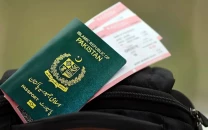Let the rupee fall and bring down discount rate
With China slowing down, we need to draw up policies that can spur economic activity

Most economists in Pakistan believe that the current exchange rate is overvalued by as much as 15%. It is not only making exports from Pakistan expensive but also creating increased competition for the domestic industry from cheaper imports. PHOTO: FILE
“When China sneezes, the world catches a cold.” Are Pakistan’s exports on the verge of pneumonia then?
Pakistan’s exports peaked in 2012, when the value touched $25.5 billion. Since then it is on a downward trajectory during which Pakistan has lost market share in most of its export markets. In the goods basket, major export products such as rice, leather, cotton yarn and textiles are also losing markets to competitors.
Rupee depreciation
In the services sector, export figures are also not depicting an optimistic outlook. The export of services peaked in 2012 and reached $6.5 billion; it now stands at $5.5 billion.
The export to GDP ratio is drifting below nine percent and is expected to go down as we foresee global economic downturn led by a decline in the international commodity prices and slowdown in major economies such as the European Union (EU) and China. The average export to GDP ratio for developing countries is 20%. In South Asia, India leads with 25% followed by Sri Lanka with 22% and Bangladesh with 20%.
The Chinese economy, which for a decade was growing at double digits, has started showing signs of exhaustion. Analysts believe that the growth of the Chinese economy this year will be below seven per cent.
Pakistan to continue purchase of dollars
Despite huge fiscal stimulus, economists believe that the Chinese economy may not reach double digit growth in the foreseeable future and is heading for a landing. Whether it would be a hard or soft landing, its jolts will be felt across the globe.
For policymakers in Pakistan it must be a cause of concern to see declining trends of exports. The textile sector, which is one of the mainstays of the export sector, has taken the biggest hit where yarn exports to China are down by as much as $1 billion.
The textile industry has started a campaign for an incentive package to revive the unit’s shutdown due to loss of exports. The government may find it difficult to inject cash due to limited fiscal space and ceiling cap on domestic borrowings imposed under IMF programme.
Pakistan’s economy enjoying period of optimism: report
The only short-term policy options to revive the export sector appear to be the monetary and exchange policy.
Most economists in Pakistan believe that the current exchange rate is overvalued by as much as 15%. It is not only making exports from Pakistan expensive but also creating increased competition for the domestic industry from cheaper imports.
Exchange rate
With a current account surplus, decline in global oil prices and healthy growth in workers’ remittances, the policy to artificially overvalue currency does not seem viable. Pakistan should let its currency drop to its market value, which would be around Rs112-115 a dollar.
Moody’s has upgraded Pakistan’s credit ratings, says Dar
The depreciation will add to government revenue as nearly half of the total revenue derives from duties and taxes on import. Furthermore, this will add to value to workers’ remittances and rid the need for unpopular measures to meet revenue targets.
Monetary measures
Secondly, monetary policy needs to be recalibrated. Currently and forecast of inflation figures depict a sub-five-percent figure. This leaves room to further cut the discount rate by two percent which will ease financial costs of exporters and spur economic activity.
So what is stopping policymakers from taking these measures? Some believe that the ego of the finance minister is responsible for pegging the value of the rupee around Rs100 against the dollar. When the present government took over, the economy was in a fragile condition. Economic stabilisation was one of the top priorities. It also led the government to subscribe to the IMF programme. Stabilising exchange rate and controlling inflation is the outcome of these measures.
World Bank appreciates Finance Minister’s vision
With foreign exchange reserves at record levels, inflation lowest in decades and oil prices down, it is time for bold measures. The devaluation of currency and further reduction in discount rates could accrue as much as $5 billion benefit to the export sector. It would also bring a $2-billion windfall in additional revenue for the FBR.
The Strategic Trade Policy of Pakistan envisages an export-led economic growth model. The exchange rate and monetary policy needs to be in sync with the overall growth objectives of the government.
The writer is a civil servant with 20 years of experience on issues related to Pakistan’s trade and development
Published in The Express Tribune, November 2nd, 2015.
Like Business on Facebook, follow @TribuneBiz on Twitter to stay informed and join in the conversation.



















COMMENTS
Comments are moderated and generally will be posted if they are on-topic and not abusive.
For more information, please see our Comments FAQ